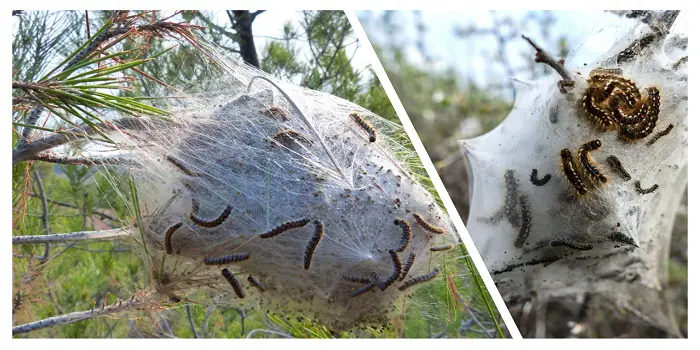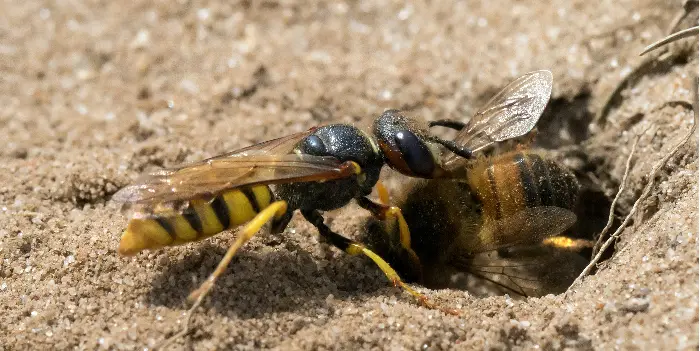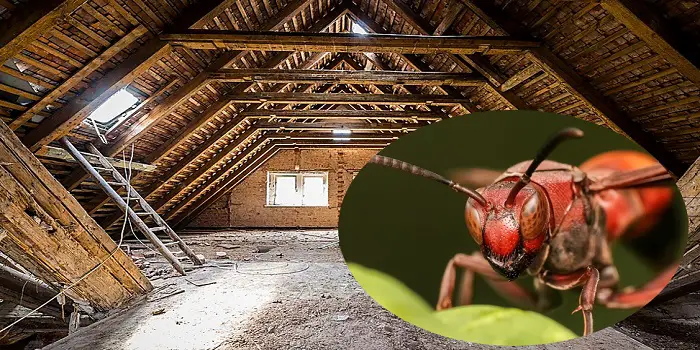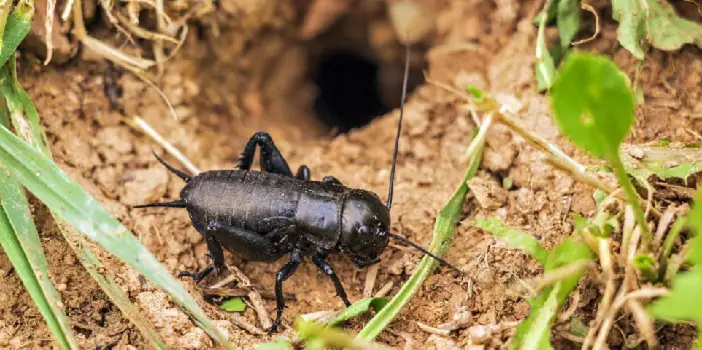
Many insects will make your garden their home.
Some are good, but some are bad and will damage as they consume the plants in your garden.
One of the most insidious is the pine processionary caterpillar.
For coniferous plants, the pine processionary caterpillar is one of the biggest threats.
Not only to the plant but also to the health of anyone who consumes the plant where this caterpillar has been.
The presence of this caterpillar is to be taken seriously as it is a threat to plants, pets, and those living in your home.
So, to deal with this threat, it is important that you recognize them by sight, learn where they nest, and what to do to get rid of them from your garden.
What is the Processionary?
The caterpillar is called a pine processionary because it primarily lives in coniferous plants such as pine.
And because they move in a serpentine fashion, the name “processionary” was also given to them.
In the wild, they are mostly found on pine trees, but they exist in urban areas where pine and cedar trees exist.
Their most distinctive feature is the long, stinging hairs that are the defense mechanism of this insect and allow it to move.
It is these toxic hairs that cause a harmful reaction to humans and pets when they contact the caterpillar directly to the skin.
Such reactions need to be treated quickly when they occur.
You can also see their nests which are quite distinctive as they look like cotton candy in a tree.
The larvae are born sometime around September in the northern hemisphere, and they move about until winter sets in.
Once that occurs, they bury themselves in the soil to create a cocoon from which they become moths or butterflies in the spring.
But before they become a moth, they are at their most dangerous in terms of being a threat to humans and pets.
It is why you need to know where they nest to identify and eliminate them from your property.
Why and Where Do They Nest?
The cause of their appearance comes from the pine and cedar trees they nest and call home.
What makes them dangerous is when such trees are near gardens that provide a food source.
Plus, if your area is experiencing high temperatures with little rain, they can also appear in greater numbers.
When winter ends, and spring begins, they often consume the different types of pine in their area.
Black pine is the most desired food source, but the caterpillars can also consume other pines as well.
This means they can move about once they leave the nest and cause damage before burying themselves in the ground.
Development stages
Processionary caterpillars usually develop in 4 different stages. These are egg, larva, chrysalis, and adult butterfly.
The nesting process normally begins in May when the butterflies mate and leave their eggs in the trees.
After a month or a little more, the eggs hatch to reveal the caterpillars.
It takes another month before their stinging hairs grow on their bodies.
The nest itself provides shelter and protection for the caterpillars from the birds that normally would feast on them.
It also helps them survive the winter before they bury themselves in the ground to create cocoons.
From the cocoons spring the butterflies, and the process starts all over again.
8 Tricks & Home Remedies to Get Rid of Pine Processionary
There are good reasons to get rid of the pine processionary caterpillars.
Many of the following methods are easy to employ, but you may have to be diligent in keeping them going until the menace is gone.
1- Bacillus Thuringiensis
This is arguably the last option, but it effectively destroys the caterpillars fast.
Bacillus Thuringiensis is a product you can find at nurseries that are used to poison the caterpillars as they consume their food source.
You’ll need to apply the product once a week during the infestation season.
The upside is that this product, when combined with other natural toxins, will penetrate the plant.
So, when the caterpillar consumes, it will become poisoned and die.
The downside is that this process only works during the larvae stage.
Once the caterpillars become adults, the product is no longer effective.
2- Kill by Hand
If you can reach the nest, you can kill the caterpillars directly.
It is best to use gloves and protection so you do not contact the stinging hairs.
One simple way is to light the nest with a match or lighter as it is flammable, then put the fire out once it has destroyed the nest with a fire extinguisher.
Fire is a brutal but effective method of killing the caterpillars.
3- Dig Up the Pupae
You can identify the places where the pupae have dug holes in the ground to create their cocoons.
They are normally near the pine where they built their nest, usually within 15 feet.
Look for a mount of sand that is a couple of inches in diameter. Dig it up, and you will find the pupae.
You can choose your method of disposal, but they need to be removed or destroyed, so they do not become butterflies.
4- Pheromones
You will need to obtain some synthetic pheromones and place them in traps.
Male butterflies will fly into the traps and die when they detect pheromones.
This will lower the population of the pine processional caterpillar considerably.
If you cannot obtain synthetic pheromones, consider calling a pest control specialist who may have some as part of their supplies.
5- Predators
These caterpillars have natural predators you can introduce to your garden to help keep them away.
Some of the more prominent ones that prey on the pine processional caterpillar include the following.
- Ants
- Bats
- Blue and Coal Tit
- Cicadas
- Wasps
While cicadas and especially wasps may not be a desirable predator to have near your home, the blue and coal tit is a lovely bird that can be attracted to your home with the right feeder and home.
Keep in mind that you still have to deal with the nest so the birds and predators can get to the caterpillars.
6- Soap & Water
This is one of the easiest methods of discouraging the caterpillars from feeding on your plants.
Create a mixture of soap and water and place it inside a spray bottle.
Spray the plants and pines with the mixture as that will discourage the caterpillars from entering.
You will need to spray every few days to ensure that the mixture does its job, but it will not affect the plants themselves.
7- Tobacco & Water
Alternatively, you can take a pack of cigarettes and place them in boiling water.
If you smoke cigarettes, then the ashes will do as well.
Once boiled and cooled down, pour the mixture into a spray bottle and use it on your plants.
You only need a little of the mixture to work as too much may damage the plants.
Tobacco carries a strong scent that keeps the caterpillars away.
8- Water Trap
This may be the simplest of all traps. Wrap a plastic container around the tree so that it can hold water on all sides.
Seal it at the bottom, so the water does not leak out.
Caterpillars descend from their nests; they will get into the water and drown.
You may want to fish out the drowned caterpillars ever so often, but this is one of the most effective ways of keeping them from getting to your lawn.
Ideally, you’ll want to use more than one method to eliminate the caterpillars.
A combination of soap and water and destroying the nests should keep the population down.
Plus, attracting natural predators to your yard will help destroy the remaining caterpillars.
Why is Processionary Dangerous for Humans and Pets?
Processionary is covered with small stinging and poisonous hairs all over its body and this is what makes these bugs dangerous.
Although they do not sting, bite or puncture the skin, they can severely affect us with their simple contact.
Humans, as well as pets, can develop severe irritations and allergic reactions (like urticaria and even conjunctivitis) if they touch the larvae of the pine processionary.
Burning sensation, reddishness, rashes, and itching are a few other symptoms that can also be caused due to these caterpillars.
And the sad part is this irritation can last for several weeks even after the treatment.
Particularly these oak processionary moths and caterpillars can be a sign of danger for your dogs and cats if they ingest them by mistake.
This often happens when your pet strolls through areas that are surrounded by pine trees.
Eating a caterpillar can cause severe abdominal pain and vomiting.
In any such circumstances, it’s important to immediately take them to a veterinarian for quick treatment.
When to Call a Professional for Pine Processionary Caterpillars Removal?
If you have tried these methods and are still not having success, a professional pest control expert is the answer.
They have the knowledge, equipment, and products necessary to identify and destroy the caterpillar.
It is true that calling a pest control expert will cost money, but it will be worth it since the threat of the caterpillar exists to your plants, pets, and your family.
The pest control expert will inspect your property, locate and destroy the nests, and use poisons or other products to dissuade the return of the caterpillars.
Because their treatments are temporary, you will need to have the pest control expert return to your property every year.
However, you may mitigate that to a certain extent if you employ some of the methods listed above.
For example, if you only have a few pines or cedar trees, the water trap is a great way to keep the caterpillars from progressing to the ground.
The Conclusion
The pine processionary caterpillar is a dangerous insect to have in your yard.
You will often see them traveling in long lines (of hundreds) in search of food and to stay away from predators.
Traveling in line will also help them from getting lost.
They also present a real threat to you, your family, your pets, and your plants.
Understanding how to deal with this threat will provide the protection needed to keep them off your property.
Share the post "How to Eliminate Pine Processionary Caterpillars in Your Garden?"

Welcome to ProShieldPest.com. I am Tina Jones. I have been working as a pest removal professional in Winslow, Arizona lately. At present, I love to spend my time with my family as a retiree.
Here I share all my knowledge and experiences to help people understand better how they can stop pests at their homes without actually killing them. Hopefully, the information you will find here will help in safeguarding your home! You can check more about me here.




